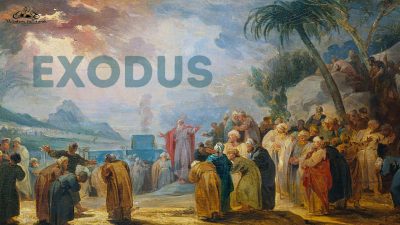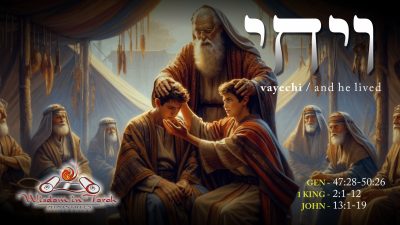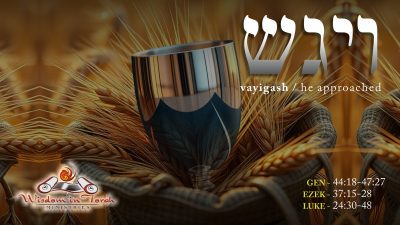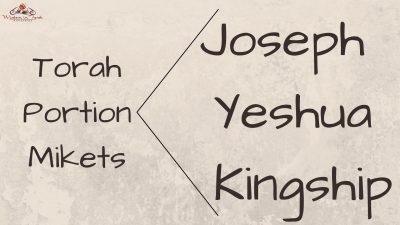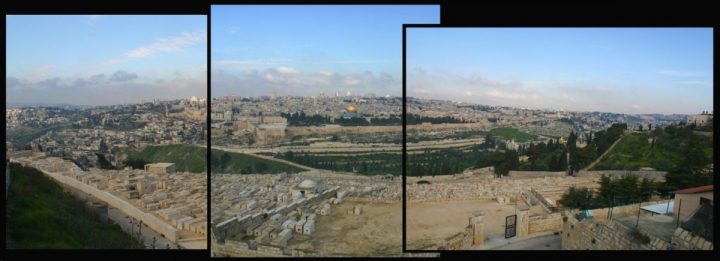
Don't Forget to Share!
Teaching from the Mount of Olives.
Be sure to check out the additional info tab
Audio
Oops, you don't have access to this content
Resources
The following is a list of recommended resources for this teaching:
- The Anchor Yale Bible Dictionary (Vol. 5, pp. 13–15). New York: Doubleday.
OLIVES, MOUNT OF (PLACE)
[Heb maʿălē hazzêtı̂m (מַעֲלֵ הַזֵּיתִים); har hazzêtı̂m (הַר הַזֵּיתִים); Gk to oros tōn elaiōn (το ὀρος των ἐλαιων); to oros kaloumenon elaiōn (το ὀρος καλουμενον ἐλαιων); tou elaiōnos (του ἐλαιωνος)]. A small ridge of three summits, about two miles long, the highest of which is not quite 3,000 feet above sea level, running N to S across from the Kidron Valley E of Jerusalem and known for its abundance of olive trees.
A. Description
B. Old Testament and Late Judaism
C. New Testament
D. Shrines on the Mount
A. Description
The Mount of Olives belongs to the Central Mountain Range, the main range of mountains which runs through the central and S portions of Palestine from the N to the S. To the W of Olivet lay the Kidron Valley and the city of Jerusalem. Toward the E lay Jericho, the Jordan Valley, and the Dead Sea. There are several undulations along the two-mile ridge separating several high points. The northernmost summit is the highest, which has been reported to be 2,963 feet above Mediterranean Sea level. This summit has been identified with Nob (Isa 10:32) and Mount Scopus (Josephus JW 2.19.4, 7; 5.4.1), but there is no certain evidence for these suggestions. This N peak today is called Ras el-Mesharif.
The center of the Mount of Olives is a bit lower (about 2,700 feet) than its N counterpart. It stands opposite the temple area and is about 100 feet higher than Jerusalem itself. To the S and SE one can see the expansive wilderness of Judea; to the E is a spectacular view of the Jordan Valley and the Dead Sea; to the W lies a deeply stirring panorama of the old city of Jerusalem. The S summit, the southernmost part of the ridge, is the smallest of the three. This peak, facing W, overlooks the ancient site of Davidic Jerusalem, just S of the temple area.
The mount itself is composed of cretaceous limestone with a chalklike top layer and was named “Olives” because of its extensive olive groves. The olive tree, one of the hardier trees, was able to thrive in this terrain. Although populous with olive trees, this ancient site was also dotted with pines. The mount, denuded of trees in the time of Titus, contains only a fraction of the tree population it had in ancient times. Today there are major deforested areas and numerous cemeteries. Since Christ often traversed this ridge and spent not a few hours in its groves, there are many commemorative churches honoring this terrain. Some of these sites, however, are questionable.
B. Old Testament and Late Judaism
Surprisingly, in spite of the close proximity of the Mount of Olives to Jerusalem, there are only two explicit references to this mount in the OT. The first reference occurs in 2 Sam 15:30. David, fleeing from Jerusalem after his son Absalom led a successful revolt, took the path which led over the crest of the Mount of Olives as he made his way to his temporary exile in the Transjordan: “David went up the ascent of the Mount of Olives, weeping as he went, barefoot and with his head covered.” Interestingly, the text recalls that “David came to the summit where God was worshipped” (2 Sam 15:32). Previously, the OT had not mentioned this “place of worship.” However, given the inclination of ancient peoples to worship on mountains, it is not impossible that a sanctuary existed here. It is tempting to identify this place of worship with Nob, but this identification is far from certain (cf. 1 Sam 21:1; 22:9–11). The second explicit reference to the Mount is found in Zechariah’s description of the Day of Yahweh: “On that day his feet shall stand on the Mount of Olives and it shall be split in two from east to west by a very wide valley; so that one half of the Mount shall withdraw northward, and the other half southward … then the Lord your God will come, and all the holy ones with him” (14:4–5).
Besides these two explicit references there are several probable implicit references. In 1 Kgs 11:7–8 mention is made of high places built by Solomon for all his foreign wives to worship the Moabite god Chemosh and the Ammonite god Molech. These places of worship, the text says, “were east of Jerusalem, to south of the Mount of Corruption” (2 Kgs 23:13). Today the Mount of Offense (variously called Mount of Corruption, Sandal, or Evil Counsel) may well be the place where these abominations occurred, but this identification is by no means certain. Some scholars see a play on words in 2 Kgs 23:13. The Hebrew word “corruption” (mašḥı̂t) is very close to the word “anointing” (māšaḥ). Thus the “mount of anointing” (Mount of Olives, from which the sacred anointing oil is produced) has become the “mount of corruption.” Though this suggestion is very possible it should be noted that the ascription Mons Offensionis (Mount of Offense) can be traced only as far back as Quaresmius of the 17th century a.d.
A second implicit reference is found in Ezekiel. The prophet was enabled to view the glory of God depart from the temple, whereupon it “stood upon the mountain which is on the east side of the city” (Ezek 11:23). Later in the book, Ezekiel reported that he saw the process reversed. In his vision of the new Jerusalem, Ezekiel saw this glory return and enter the eschatological temple (43:2–5). The mountain referred to by Ezekiel is commonly understood as Olivet.
The Mount of Olives has also been associated with the rite of the burning of the red heifer so that its ashes could serve as a purification (Num 19:1–10). According to the Talmud, this purification rite was performed on the Mount of Olives opposite the E gate of the temple (Para 3.6–7, 11). Moreover, the Mishnah claims that Jews in Jerusalem announced the new moon to their brethren in Babylonia by means of a chain of fire signals, the first of which began on Olivet. Furthermore, according to tradition, the dove sent forth from the ark by Noah retrieved the olive branch from the Mount of Olives (Ge 8:11; Gen. Rab. 33:6). Tradition also suggests that those faithful Jews who died abroad would be channeled back to Jerusalem through underground caverns and be resurrected and emerge at the sundered Mount of Olives (m. Ketub. 111a). Also, when the glory of God departed from the temple it was to have tarried three and a half years on Olivet while eagerly awaiting Israel’s repentance (Lam. Rab. Proem 25; cf. Ezek 10:18).
C. New Testament
Almost certainly, Jesus traversed this mountain many times to and from feasts and festivals in Jerusalem. Although this route could have been avoided and a route directly N through Samaria followed, the Jewish custom was to head E and then N to avoid stepping on Samaritan soil. Despite the numerous trips using this circuitous route, apart from Jesus’ final week of ministry the Mount of Olives is mentioned only infrequently.
The references to the Mount of Olives outside the passion week occur at John 8:1, the pericope of the woman taken in adultery (many scholars seriously question the authenticity of John 7:53–8:11), and Acts 1:12 (cf. Luke 24:50–53), in which Jesus’ ascension is described. There may also be several implicit references outside of Jesus’ passion week. These references include the visit to Mary and Martha where Mary is affirmed for seeking to be taught (Luke 10:38–42); the raising of Lazarus (John 11); and the feast “six days before the Passover” (John 12:1; cf. Matt 26:6–12; Mark 14:3–9). Although none of these pericopes explicitly mentions the Mount of Olives, nevertheless they all occurred at or near Bethany, which is on the E side of the mountain.
With regard to the passion week, the references to Olivet are numerous. The triumphal entry, which began at Bethany and terminated in Jerusalem, explicitly mentions the Mount of Olives (Matt 21:1–11; Mark 11:1–10; Luke 19:28–39; John 12:12–15). While proceeding into Jerusalem, Jesus paused on Olivet and wept over the unrepentant Jewish nation (Luke 19:41–44); traditionally this site has been marked by the Dominus Flevit chapel, but this identification is by no means certain. Apparently Jesus did not lodge in Jerusalem during his final week, but rather in Bethany, probably at the home of Mary and Martha or perhaps with Simon the leper (cf. Mark 11:11; 14:3; Luke 21:37). The Gospels’ description of Bethany suggests an identification with the Arab village of el-Azariyeh. Bethphage was apparently adjacent to Bethany, but nearer the top of the Mount of Olives. Abu-Dis probably corresponds to this city today, although some identify it with the village et-Tur on the very top.
The cursing of the fig tree, occurring the day after the triumphal entry, took place on Jesus’ evening return to Bethany (Matt 21:17–19; Mark 11:11–14; 19–20) and probably occurred on this mountain. It is also likely that the Mount of Olives was in view when Jesus taught that the person of faith could say to the mountain, “Be taken up and cast into the sea,” and it would occur (Matt 21:21). Also during his passion week, Jesus gave his disciples an eschatological outline (Matthew 24; Mark 13) from “the Mount of Olives opposite the temple” (Mark 13:3; cf. Matt 24:3). Luke informs us that during the evenings of the passion week, Jesus tarried on Mount Olivet (Luke 21:37). The seclusion of the groves was probably heartily welcomed after the rigor of teaching in the temple all day. It is probably from this mountain that Jesus sent his disciples into Jerusalem (Matt 26:18; Luke 22:8) to prepare the Passover. After celebrating this feast in the city, they sang a hymn and went to the Mount of Olives (Matt 26:30; Mark 14:26; Luke 22:39; cf. John 18:1). Jesus’ destination on the Mount of Olives was the garden of Gethsemane (Matt 26:36). This garden was probably located on the W side of Olivet, and here Jesus agonized before his Father in prayer (Matt 26:30, 36ff.; Mark 14:26, 32ff.; Luke 22:30ff.; John 18:1ff.). It was also in this place that Jesus was betrayed by Judas and seized by the soldiers (John 18:12; cf. Matt 26:47–57; Mark 14:43–50; Luke 22:47–54).
D. Shrines on the Mount
Only the city of Jerusalem would have a greater concentration of shrines than the Mount of Olives. Most of these shrines are related to events named in the NT, but their origin and accuracy are nonetheless problematic. For example, there are three triumphal entry trails, three gardens of Gethsemane, three sites for Jesus’ ascension, two Jericho roads, etc. There is even a shrine over the supposed “last footprint of Christ.”
A basilica dedicated in the name of Helena, Constantine’s mother, was probably the first shrine on Olivet. Located on the S end of the central hill, it was built ca. 325 and is called the Eleona (“Olives”). It was destroyed in the 7th century by the Persians, but became the site upon which the Church of the Pater Noster was built in 1869. Ostensibly the Lord’s Prayer was taught on the ground marked by this church and therefore the walls are covered with versions of the Lord’s Prayer in no less than sixty different languages. Also on the mount stands a Greek orthodox monastery, Viri Galilaei, which reportedly draws its name from Acts 1:11: “Men of Galilee, why do you stand looking into heaven?” Thus the “mountain of Galilee” (Matt 28:15) is dubiously identified with a place on the Mount of Olives. A chapel marking the ascension of Christ is located at the summit of Olivet. Built in 1834, this sanctuary also houses a stone which some have claimed contains the footprints of Jesus.
On the W slope of the Mount of Olives the visitor can choose one of three possible sites for the garden of Gethsemane, commemorated by three different churches. The first one, near the center of the W slope, is the Russian Church of Mary Magdalene. The more celebrated Roman Catholic Church of All Nations, with its Stone of the Agony in front of the altar, lies just below it. The garden, marked by the Church of All Nations, contains olive trees which probably were planted about a millennium ago. Thirdly, the Armenian Gethsemane, with its church built ca. 455, claims to be the site of the burial of Mary. Though not a shrine, the German hospice, Augusta Victoria, built by Kaiser Wilhelm II, located on the N of the Mount of Olives also deserves special mention. In digging its foundation in 1907 an ancient settlement was uncovered. Because of the association of the valley of Jehoshaphat with the Day of the Lord, there is an extensive tradition of religious burials on the Mount of Olives. Included among the burials are James, the Apostle; Mary, the mother of Jesus; Joachim and Anna, Mary’s parents; and Joseph, the husband of Mary.
The Mount of Olives is also important in the Moslem tradition. A Muslim shrine, the Inbomom, built around 375, contains what is claimed to be the last footprint of Christ upon earth. Of greater importance is the Islamic belief that the final judgment will occur in the Kidron Valley between the Mount of Olives and the celebrated Jerusalem shrine, Dome of the Rock. Ibn el-Gaqih summarizes this final cataclysm: “The Mount of Olives faces the Mosque, and between them is the Valley of Ben Hinnom, and from it ‘Isa [Jesus] ascended to Heaven. And on the Day of Judgment all souls will be gathered to it and they will cross the bridge over the valley of Jehoshaphat, some to Paradise and some to Gehenham.” Additionally, Muslim tradition asserts that Olivet is holy because “Saffiya, the wife of the prophet … prayed there.”
Bibliography
Baldi, D. 1955. 265 Enchiridion Locorum Sanctorum. Jerusalem.
Dalman, G. 1935. Sacred Sites and Ways. New York.
Hacohen, M. 1962. 513 Har Hazeitim. Jerusalem (in Hebrew).
Hoede, E. 1973. Guide to the Holy Land. 7th ed. Jerusalem.
Katsh, A. 1954. Judaism in Islam. New York.
Kraeling, E. G. 1956. Bible Atlas. New York.
Vincent, H., and Abel, F.-M. 1914–16. Jérusalem Nouvelle. Vol. 2. Paris.
Warren J. Heard, Jr.
N north (ern)
S south (ern)
E east (ern); or “Elohist” source
S south (ern)
N north (ern)
S south (ern)
W west (ern)
E east (ern); or “Elohist” source
JW Josephus, The Jewish War (= Bellum Judaicum)
N north (ern)
N north (ern)
S south (ern)
SE southeast (ern)
E east (ern); or “Elohist” source
W west (ern)
S south (ern)
W west (ern)
S south (ern)
E east (ern); or “Elohist” source
Para Para
Rab. Rabbah (following abbreviation for biblical book: Gen. Rab. = Genesis Rabbah)
Ketub. Ketubot
Rab. Rabbah (following abbreviation for biblical book: Gen. Rab. = Genesis Rabbah)
N north (ern)
E east (ern); or “Elohist” source
N north (ern)
E east (ern); or “Elohist” source
W west (ern)
S south (ern)
ca. circa (about, approximately)
W west (ern)
W west (ern)
ca. circa (about, approximately)
N north (ern)
Warren J. Heard, Jr. Assistant Professor of NT, Trinity Evangelical Divinity School, Deerfield, IL
Heard, W. J., Jr. (1992). Olives, Mount of (Place). In D. N. Freedman (Ed.), The Anchor Yale Bible Dictionary (Vol. 5, pp. 13–15). New York: Doubleday.

